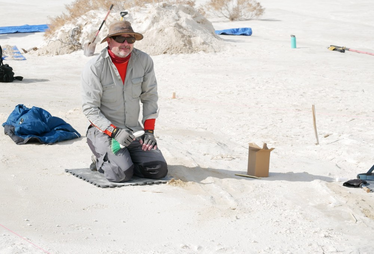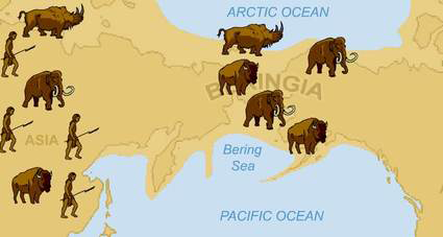 Michael Bennett; Photo credit: Bournemouth University Michael Bennett; Photo credit: Bournemouth University This moment and these findings have something to teach us about intellectual virtue and the nature of science. Some very tenacious researchers at White Sands had literally been digging in these dunes for decades when the new prints were exposed. The geologists who uncovered them had been over this region a dozen times before, seeking, wondering. But one day in 2019 high winds literally turned back the sands of time, and tireless British geologist Michael Bennett along with White Sands Park Director David Bustos beheld a different landscape. Exposed in the bluff were undeniably human footprints fading into a mound of sand. The two held their breath and forged forward. Gentle scraping exposed outlines of a buried track. “At that point,” Bennett recalled, “we said Bingo, we’ve got it.” White Sands had been on geologists’ radar since the 1930s, when a twenty-two-inch footprint thought to be the mythical “Bigfoot,” was discovered there. The remarkable print turned out to be a giant ground sloth, and in subsequent years ancient human and extinct animal prints were discovered nearby, dating to perhaps ten thousand years ago. Maybe more… But radiocarbon dating is a tricky business and requires seed samples from above and below the imprints, from which the age can be calculated. Many tracks are better than one. That’s why the 2019 discovery is breathtaking.
 The dating of seeds above and below the prints suggests humans and animals tramped here between 21,000 and 23,000 years ago. “We’ve really tried to prove it’s not that old, and we keep coming up dry,” Daniel Odess, archaeologist and one of the authors of the study reports. Layer after layer of track yields the same data. Wow. Of course, caution should prevail. Is there anything “off” about these radiocarbon dating results? Can a second method of dating be found? Or do these new findings constitute a body of evidence so overwhelming that it’s time to alter former theories? We don’t know yet, and I am a student of history not science, but I’m betting on a paradigm shift. And that will challenge teachers. For almost three decades first graders in Core Knowledge Schools across the country --and high schoolers everywhere--have been learning that human settlement in the Americas dates to the end of the last Ice Age. I personally wrote and recorded song a called “Back in the Ice Age” that hundreds of former Crossroads Academy students can sing. It has the lyrics “Back in the Ice Age, twenty thousand years ago…woolly mammoths crossed the land bridge with hunters close behind, from Asia to America, a new world they did find, back in the Ice Age.” Now what? Maybe I just change the lyrics to “Before the ice froze, thirty thousand years ago….” In October the Core Virtues program spotlights the virtues of diligence and perseverance. Those are indispensable intellectual excellences: care in our work, pressing on despite difficulty. My hat is off to the tenacious team of international researchers at White Sands, who worked assiduously and never gave up on an elusive quest. Well done, noble scholars! And I tip my hat too to the 22,000-year-old teens and kids, who left their mark, perhaps drawing water for their folks at the now extinct “Lake Otero,” where the prints remain. And let’s not forget to spotlight two other intellectual virtues these scientists displayed, ones that are also cultivated at Core Virtues Schools: openness to inquiry and humility in the face of facts. Those traits are key to the progress of knowledge in general and science in particular. Scientists construct theories (or “paradigms”) of what happened in accord with the most reliable data they have. For years, it has seemed from dating of glacial moraines, ice cores, human remains and artifacts that a post-Ice Age crossing was the most likely explanation of human settlement in the Americas. But that is a theory, not a fact. And science is a process. New evidence hinted the theory might be incorrect, and an intrepid few researchers were open to questioning how “settled” the science was. They didn’t shy away from research that might yield pre-thirteen-thousand-year-old results. Colorado geologist Thomas Stafford notes that it has not been common scientific practice to think past that date. As a radiocarbon dating expert, he would often receive samples to date and be told not to bother looking past the thirteen-thousand-year material. “If you’re not looking for anything, you’re not going to find it,” Stafford says. Openness to inquiry must guide intellectual endeavor. When advocates for various theories and policies proclaim, “the science is settled,” all our alarm bells should go off. On highly complex issues, the science is hardly ever “settled.” Ask Copernicus. Ask Galileo. Ask Einstein. Ask Michael Bennett. Nature surprises us, and our understanding evolves. We have to be humble enough to allow that evolution -- admit that we might not know it all. Meanwhile, what do we teach those first graders and high school students about how human beings came to inhabit the Americas? Maybe we say: Well, it was a very long time ago, and because we don’t have written records and our scientists are literally still digging, we don’t know for sure. But here’s what we think. Early human hunters probably crossed from Asia to America at a time when that area wasn’t covered with ice. That could have been before the last Ice Age. We used to think we humans came at the end of the Ice Age, but now we’re not sure because of evidence found in our own national park at White Sands, New Mexico. Maybe you can help solve that puzzle if you become an archaeologist or geologist. And teachers shouldn’t miss the opportunity to tell students they should learn some lessons from those Ice Age youth. When your parents tell you to take your little brother or sister and go do something, just do it. Leave a legacy….. Mary Beth Klee, Ph.D. has taught the Ice Age unit to first graders numerous times and now needs to regroup.
The Bennett, et. al. study is at https://www.science.org/doi/10.1126/science.abg7586 and the National Geographic article at https://www.nationalgeographic.com/history/article/fossil-footprints-challenge-theory-when-people-first-arrived-americas. And for another thought-provoking challenge to a realm in which “the science is settled,” read New York University physicist and Obama Under Secretary of Energy Steven Koonin’s latest work Unsettled. What Climate Science Tells Us, What it Doesn’t and Why it Matters. (April 2021) To read more from Telling Our Stories, visit our Blog Archives page. |
AuthorWrite something about yourself. No need to be fancy, just an overview. Archives
July 2024
Categories |
